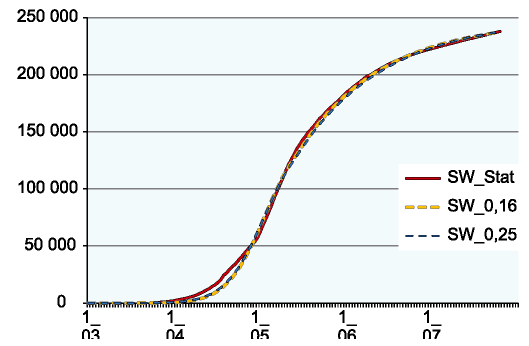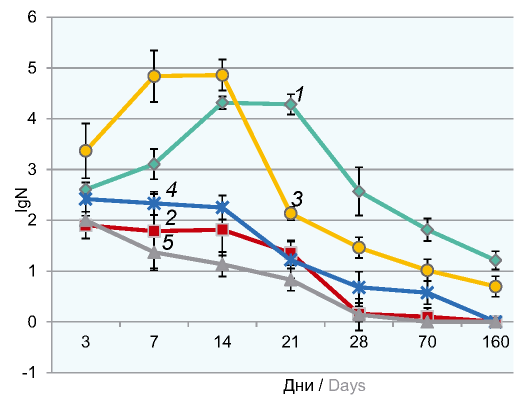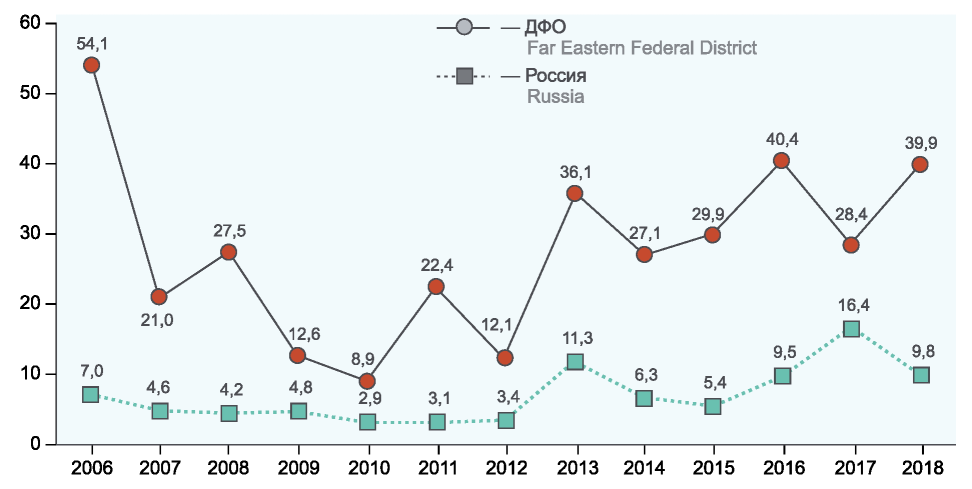Vol 97, No 4 (2020)
- Year: 2020
- Published: 02.09.2020
- Articles: 10
- URL: https://microbiol.crie.ru/jour/issue/view/38
Full Issue
ORIGINAL RESEARCHES
Predicting the dynamics of Covid-19 incidence and planning preventive vaccination measures for Moscow population based on mathematical modeling
Abstract
The results of the predictive analytical studies on Covid-19 incidence dynamics in Moscow, taking into account different changes in epidemic prevention measures, including vaccination coverage of the population, are presented.
Research Objective. Using the new epidemiological model for analysis and prediction of the Covid-19 incidence dynamics in Moscow and outlining main strategies in implementing epidemic prevention measures (EPMs), including vaccination in 2020/2021.
Materials and methods. The epidemiological model is based on the Russian approach to mathematical modeling of epidemics, known as Epiddynamics. The medium-term forecasting incorporated probable scenarios of epidemic development with different EPMs (isolation of the infected and contacts, breaking the transmission chains), including different rates of vaccination coverage in Moscow.
Results and discussion. The computational simulations demonstrated that the incidence rate is likely to increase with scaling down EPMs and zero vaccination coverage. At the same time, the daily incidence rate depends on the degree of EPMs reduction and basically does not depend on the time when the reduction begins. With scaled-down EPMs, vaccination can decrease the incidence, though its effectiveness will depend on the time of its commencement, coverage and rate.
Conclusion. The computational simulations showed that the vaccination will be efficient for prevention of new surges in COVID-19 cases only if the other EPMs (isolation of the infected and contacts, breaking the transmission chains) are still in place until the vaccination coverage reaches about 2 million people. Ideally, the measures aimed at isolation and breaking of transmission chains should be continued until the total vaccination coverage reaches 4 million people, after which the restrictive measures can be scaled down significantly. With vaccination coverage of 50% of the population of Moscow, the restrictive measures can be completely discontinued.
 289-302
289-302


Characterization of markers of cold-adapted candidate virus strains for live attenuated vaccines against chickenpox and shingles
Abstract
Introduction. Chickenpox poses a significant public health concern due to its worldwide occurrence, a substantial probability of severe clinical progression, development of complications that can lead to a fatal outcome. Routine vaccination is the only way to prevent the disease. The purpose of this study was to assess the attenuation of cold-adapted (CA) candidate virus strains of Varicella zoster and Herpes zoster by using traditional and new methods.
Materials and methods. The study was performed on strains of diploid cells from human embryonic lung and musculocutaneous tissue, primary and diploid cells of guinea pig fetal fibroblasts. Two clinical isolates of the virus were obtained — from a child with chickenpox and from an adult during the reactivation of shingles. The vOka vaccine strain and Ellen strain, a laboratory strain, were used as a control. The viral infectivity was measured by using a sensitive limiting dilution assay. The virulence was measured through the analysis of chick embryo chorioallantoic membranes infected with the Varicella zoster virus.
Results. The clinical isolates were sub-cultured at lower temperatures, put through comparative tests and checked for presence of attenuation biomarkers. It was found that vFiraVax, a Varicella zoster virus strain, and vZelVax, a Herpes zoster virus strain were temperature-sensitive and cold-adaptable, but they lacked virulence. Attenuated CA virus strains induced lower expression of IFN-α and IFN-γ receptors on human mononuclear cells as compared to their parental variants.
Conclusion. We created and assessed two candidate vaccine strains through attenuation of clinical isolates.
 303-311
303-311


Preclinical studies of safety, immunogenicity and protective activity of attenuated Bordetella pertussis bacteria on the Macaca mulatta model
Abstract
Introduction. An increasing incidence of pertussis among different groups of population and shortcomings of the existing preventive solutions pinpoint urgency of development of new safe vaccines suitable for immunization of infants and for booster immunization of adolescents and adults.
The purpose of this study is evaluation of safety, immunogenicity and protective activity of the new constructed attenuated Bordetella pertussis bacteria 4MKS by infecting immunized Macaca mulatta monkeys intranasally with virulent bacteria of the pertussis pathogen.
Materials and methods. Five adult, clinically healthy Macaca mulatta monkeys aged 3–4 years were used for immunization and experimental infection. The re-immunization was performed in 6 months. Three non-immunized animals of the same age were used as controls.
Results. The intranasal single-dose inoculation and re-inoculation of attenuated B. pertussis bacteria did not cause any nasopharyngeal inflammation in the rhesus monkeys and any changes in the blood lab test values after the nonhuman primates had been infected with virulent bacteria. No elevation of total IgE was detected in blood serum of the Macaca mulatta monkeys after the single-dose and double-dose immunization. When the monkeys were intranasally immunized with attenuated and virulent B. pertussis bacteria, they developed a defensive reaction to re-infection, namely suppression of the bacterial growth, increased rates of elimination of bacteria from the animals’ nasopharynxes and development of a humoral immune response to the infection. The development of immunity against pertussis re-infection is accompanied by a pronounced booster effect.
Discussion. The obtained results suggest common mechanisms of development both of post-vaccination immunity after intranasal vaccination of animals and infection-acquired immunity against pertussis. Both of them provide protection against re-infection with B. pertussis bacteria and prevent development of clinical symptoms of pertussis.
 312-323
312-323


Molecular epidemiological features of the Coxsackievirus A10 circulation in the Far Eastern Federal District of Russia
Abstract
Background. Increase in incidence rates of enterovirus infections in the Far Eastern Federal District of Russia is observed annually. There is a wide genetic diversity of circulating non-polio enteroviruses. Some of them have been constantly identified for a number of years in the population of the district, including the Coxsackie A10 virus.
Purpose. To study the features of the Coxsackievirus A10 circulation in the Far Eastern Federal District of Russia in 2014–2018.
Methods. For this work, 117 Coxsackievirus A10 complete sequences of the VP1 gene were used, which were isolated in the Far Eastern Federal District of Russia in 2014–2018.
Results. Phylogenetic analysis revealed two Coxsackievirus A10 lineages in the Far Eastern Federal District of Russia in 2014-2018, while their simultaneous circulation was noted in the Sakhalin region in 2017. Active population migration contributes to the widespread distribution of Coxsackievirus A10 in border areas with the formation of epidemic variants.
Conclusion. Coxsackievirus A10 is one of the most relevant types of non-polio enteroviruses for the Far Eastern Federal District of Russia. Phylogenetic analysis revealed its genetic diversity and suggested both European and Asian origin of the obtained strains.
 324-330
324-330


Features of obtaining the protein complex of vegetative cultures Bacillus anthracis for proteomic mapping of strains
Abstract
Introduction. The study of the protein composition of the causative agent of anthrax — Bacillus anthracis, allows you to identify both general species and individual characteristics of strains that differ in phenotypic properties, manifested mainly in the vegetative form and which are important for virulence, immunogenicity and the ability to adapt to different vegetation conditions.
Purpose of the work. In the group of anthrax microbe strains having different plasmid composition and virulence, different methods of extraction of the total proteome from vegetative bacillus cells have been tested.
Results. In the course of the work, it was shown that the rate of spore formation varies significantly between individual strains of the anthrax microbe and can have a significant impact on the efficiency of extraction and the composition of the protein complex. Preliminary treatment with lysozyme, which affects the cell membrane, promotes a more complete lysis of cells, and ultramicrocentrifuge filtration provides complete specific sterility of the obtained samples.
Conclusion. A culture preparation scheme was developed for B. anthracis, which allows one to obtain a culture in the vegetative phase of the life cycle and to efficiently extract proteins in combination with reliable disinfection of samples.
 331-338
331-338


SCIENCE AND PRACTICE
Reactogenicity, safety and immunological efficacy of the live, pentavalent rotavirus vaccine in childhood immunization (results of the multicenter clinical trial)
Abstract
Introduction. Rotavirus infection (RVI) is the most common cause of severe gastroenteritis in infants and young children worldwide: 600,000 children die annually; it accounts for approximately 3 million hospitalizations and 25 million physician visits each year among children. Preventive vaccination is universally recognized as the most effective measure against this infection.
The purpose of the study is assessment of reactogenicity, safety and immunogenicity of the pentavalent live vaccine for RVI prevention in childhood immunization.
Materials and methods. The first multicenter prospective, randomized, double-blind, placebo-controlled clinical trial of the pentavalent live vaccine for RVI prevention was conducted in Russia among healthy infants aged 2 months at the time of the first vaccination.
Results. The vaccine had a satisfactory safety profile and high immunologic activity when administered in a threedose series for childhood immunization. No negative changes in the children’s health condition were detected during the surveillance monitoring.
Discussion. The seroconversion rates, the seroconversion factor and the geometric mean antibody titer were consistent with the results obtained during trials of the above vaccine and its equivalents in other countries.
 363-374
363-374


Modern practices of immunizing children exposed to HIV and HIV-infected
Abstract
The purpose of the study is to adjust the tactics of immunization of children exposed to HIV and HIV-infected people on the basis of studying modern vaccination practices within the framework of the National Calendar of Preventive Vaccinations (NCPV).
Materials and methods. According to the information in the patient's outpatient card, the card of preventive vaccinations and the history of the child's development, the completeness and timeliness of immunization of 216 children exposed to HIV and 198 HIV-infected children were analyzed. The control group consisted of 100 children born to mothers with negative HIV status. In order to study adherence to vaccines, a survey was conducted among 160 parents of children registered in the dispensary for HIV infection.
Results. It was established that, despite the delayed immunization, the coverage of vaccination against the major infections from NCPV among children ranged from 94.4% to 97.5%. The greatest difficulties in the implementation of the NCPV arose when immunizing children under 2 years of age. The “missed opportunities” during immunization subsequently led to a violation of the calendar terms of vaccinations and their implementation at an older age. The number of “missed vaccinations” in the study cohort did not exceed the criteria recommended by WHO (10%) and amounted to 5.8% for certain types of vaccines (DTP and polio).
The proportion of children vaccinated against tuberculosis in the maternity hospital in the HIV-exposed group was 2 times less compared to the control group, however, there were no differences in the incidence of vaccine induced allergy.
During the vaccination of children with HIV on the highly active antiretroviral therapy (HAART), the number of CD4 lymphocytes corresponded to the parameters of the age norm. Compared to baseline data, no changes in the immune status of vaccinees were recorded.
Organizational omissions in immunizing children with HIV infection were the use of live polio vaccine, a 3-dose vaccination schedule against viral hepatitis B in children at risk, and vaccination against tuberculosis in the absence of a three-stage chemoprevention of mother-to-child transmission of HIV.
When assessing parental vaccine adherence, it was found that 85% of respondents considered vaccination necessary for the prevention of infectious diseases, 11.3% found it difficult to answer, due to the possible risk of vaccine reactions and the lack of guaranteed protection, and 3.8% were against vaccination, citing own opinion.
The most authoritative source of information for most respondents, both positive for vaccination and those who doubted its need, was medical workers (98.5 and 72.7%, respectively). In 33.3% of those who are negatively related to vaccines, health workers were also a source of information.
Conclusion. The analysis of the completeness and timeliness of vaccinations in a cohort of HIV-infected and exposed to HIV revealed the most problematic issues regarding vaccinations within the time periods regulated by the NCPV. Children with HIV infection who have the 1st category of immune disorders on the background of HAART are subject to vaccination in the framework of the National calendar of vaccinations to full extent. The use of combined vaccines will make it possible to reduce the manipulation load in this cohort, overcome the identified inconsistencies and optimize the vaccination calendar.
 375-384
375-384


REVIEWS
Angiotensin-converting enzyme 2. Approaches to pathogenetic therapy of COVID-19
Abstract
The SARS-CoV-2 virus is a pathogen causing the coronavirus infection that culminated in a worldwide pandemic in 2020. It belongs to β-coronaviruses and has high genetic similarity to the SARS-CoV virus that is responsible for an outbreak of severe acute respiratory syndrome in 2002–2003. The analysis of molecular interactions shows that SARS-CoV-2 has higher virulence due to lower binding free energy in interaction with the angiotensin-converting enzyme 2 (ACE2), which is used by the virus to enter the host cell. At the time of the global coronavirus pandemic, the thorough study of ACE2 as a key component of the disease pathogenesis comes to the fore. The detailed study of the enzyme, which is a receptor located on the surface of different tissues and which normally catalyzes the conversion of angiotensin II to angiotensin (1–7), led to diverging conclusions. Being non-tissue specific, the receptor is abundantly present in the heart, kidneys, small intestine, testes, thyroid, and adipose tissue. Besides regulating blood pressure, it suppresses inflammation, mainly in the lung tissue, participates in amino acid transport and maintains the activity of the gut microbiome. With all its essential positive functions, the role of ACE2 is highly ambiguous, specifically in coronavirus infection. The influence on the renin-angiotensin system can be seen as a promising therapeutic route in treatment of coronavirus infection. The preliminary data on using of ACE2 inhibitors, soluble forms of ACE2, and angiotensin II receptor blockers demonstrate their effectiveness and, consequently, improvement in symptoms and prognoses for patients with coronavirus infection. The review presents information about ACE2 distribution in human tissues, explores its interaction with SARS-CoV-2, provides a theoretical basis for medications involving ACE2 metabolic pathways and for using them in treatment of coronavirus infection and its prevention.
 339-345
339-345


A modern view of pro-/eukaryote interactions in the human body as the basis for development of next-generation probiotics
Abstract
Multicellular organisms and the saprophytic flora form complex, highly integrated chimeric systems (associative symbioses, metaorganisms) characterized by interplay between pro- and eukaryotic components. To be able to interact symbiotically microorganisms (MO) need a whole body.
When grown on artificial media for a long time, symbiotic MO have to adapt to the artificial environment and gradually, though reversibly, lose their ability of associative interaction with the human body, thus causing a decrease in the therapeutic efficacy of MO-derived probiotic products. To increase the therapeutic activity of probiotic MO, they must be functionally rehabilitated.
A pathological process induces development of a secondary metabolic dysbiosis; as a result, changes in the regulatory processes of an individual interfere with the restoration of the normal microflora. Therefore, functional rehabilitation of probiotic MO must take place during cultivation, while the cultivation process must replicate the whole-body conditions.
 346-355
346-355


Identification of microorganisms using gas chromato-massspectrometry
Abstract
The review presents the basic information available in literature on the use of gas chromatography-massspectrometry. Issues concerning the significance of this method for the identification of microorganisms are discussed. The prospects of creating domestic software and databases of mass spectra of microorganisms are noted.
 356-362
356-362















